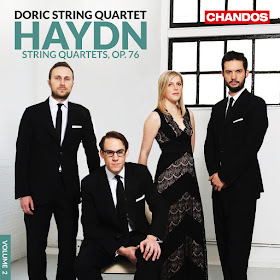I first came across the Irish pianist Michael McHale
through his work accompanying the clarinetist Michael Collins, and then I very
much enjoyed his solo release, ‘The Irish Piano’ (my review here), which mixed composers such as
John Field, Arnold Bax and Samuel Barber with traditional music, including some
of his own arrangements. For his current
disc, he has joined forces with the Irish record label Ergodos, run by two
contemporary composers, Garrett Sholdice and Benedict Schlepper-Connolly,
interspersing Schubert’s first set of Four Impromptus, D899 with three
contemporary works written as companion interludes. Schubert produced two sets of four
Impromptus, all composed in the year before his death at age 31. They are intimate works, and as is often the
case with Schubert, their relatively simple structure belies the depth of
emotion and moments of profundity that he achieves in these short pieces.
McHale’s Impromptus are respectful and expressive, and he plays with delicacy
and precision. The singing legato melody over the rippling accompaniment in No.
3 is particularly beautifully executed, and No. 4 is taken at a healthily brisk
tempo, although conversely he takes No. 1 at a slightly leisurely pace, which
loses some of the impact of its more passionate moments. Simon O’Connor’s ‘Self portrait’ picks up on
rhythmic elements and motifs from the first Impromptu, and in a stop-start kind
of way creates a contemplative atmosphere in keeping with the Schubert,
although perhaps without the outbursts of controlled passion that are always
close to the surface in the Impromptus. In
‘Was du mir warst’, Benedict Schlepper-Connolly draws inspiration from a letter
written by Schubert in his final days, and this has a nostalgic, wistful feel
to it. It is an improvisatory piece,
again very much creating an atmosphere and a mood, rather than having a clear
direction. The final interlude is by
Garrett Sholdice, and is titled ‘The dreams flow down, too’, which is a reference
to Schubert’s song ‘Nacht und Traüme’, from which Sholdice also quotes. This has a definite dream-like quality, and
in its darkly mysterious, heavily pedaled harmonies, it hints at disturbed
dreams, if not actual nightmares. All
three of these contemporary works are highly effective in their own ways, and
sit alongside the Impromptus remarkably well.
Whilst none stray very far from contemplative, atmospheric mood-writing,
they certainly pick up on the nocturnal nature of the Impromptus, if perhaps
not equalling Schubert’s emotional complexity of Schubert. McHale performs the pieces convincingly and
with incredible subtlety of touch, particularly in the eerily quiet conclusion
to Sholdice’s piece. A fascinating
glimpse into the work of three contemporary composers, and strong performances
of these and the Schubert Impromptus from McHale.
Beethoven’s
ten Sonatas for piano and violin are almost all early works – only Op. 96 comes
from his middle period. So we don’t see
the full stylistic progression that we see in the piano sonatas, or symphonies,
for example. However, they are
nonetheless all significant works in the violin/piano repertoire, and violinist
Tasmin Little and pianist Martin Roscoe’s full set recording is a welcome
addition to a somewhat crowded field. They
have performed together extensively, and their affinity is clear throughout
these warm renditions. In the earliest
works, the three Op. 12 Sonatas, Little’s tone could be stylistically a little
lighter, but she and Roscoe characterise the slow movement variations with
enjoyable subtlety, and her warm tone comes into its own with Op. 23 and beyond. The opening of Op. 30 No. 2 has great drama
from both the piano and violin entries, and this serves as a good reminder that
these are definitely works for two equal instruments, not solo violin works
with piano ‘backing’. This is where the
strength of Little and Roscoe’s equal partnership stands them in good stead –
one never feels Little is taking over too much of the limelight, and the two
performers respond to each other instinctively.
The galloping opening movement of Op. 23, and the glorious Op. 24,
‘Spring Sonata’ are perfect examples, with the exchange of the latter’s opening
melody between violin and piano deftly matched. Their Op. 47, the ‘Kreutzer’
Sonata (named after its dedication to the famous violinist), is spirited and
sensitive at the same time, with a heartfelt opening exchange between the
Bach-like solo violin passages and the answering darker piano harmonies, and a
bouncing finale. This is a strong
collection from two excellent performers, highly recommended.
(Edited versions of these reviews first appeared in GScene, September 2016)



No comments:
Post a Comment